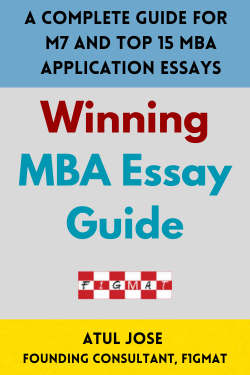MBA applicants should calculate the return on investment before choosing one program over the other. We advise against shortlisting schools purely based on ROI, but when it comes to choosing your dream school, and say if you are stuck with two equally good ones – Harvard and Stanford, a term commonly used by Finance professionals comes into consideration – Net Present Value.
In this illustration on calculating ROI for an MBA program, we cover:
- Net Present Value – Definition
- Formula for Net Present Value
- Real Rate of Interest
- Calculation – Pre-MBA Salary & Total Expense (Harvard vs. Stanford MBA)
- Harvard MBA ROI: NPV Calculation
- Stanford MBA ROI: NPV Calculation
Net Present Value - Definition
Net present value is the net value of cash inflows and outflows for a period in the future, based on the current value of the investment.
When you calculate Return on investment for an MBA program where your expense is calculated over 2 years, the returns that you earn after 2 years and subsequent years must be calculated at current value.
Let us compare Harvard vs. Stanford and find out which program offers a better return on investment. The data is based on the latest total costs of Harvard and Stanford MBA programs.
Harvard- $266,048
Stanford- $276,542
For the post-MBA Salary, we captured the total median base salary for the Consulting Industry.
Harvard - $190,000
Stanford - $190,000
Formula for Net Present Value
Future Value = Present Value (1 + Rate of Interest) ^ n
Present Value = Future Value/((1 + Rate of Interest) ^ n)
Real Rate of Interest
According to the latest figures published by the US government, interest rates are set to be 4.25% to 4.5% in 2025, 3.75% in 2026, and 3.5% in 2027. The IMF forecasts based on CPI (consumer price index) inflation are 3.2% in 2025. 2.2% in 2026, and 2% in 2027. The real rate of interest is the difference between the interest rate and the CPI inflation rate.
| Real Rate of Interest | Year |
| 1.3% | 2025 |
| 1.55% | 2026 |
| 1.5% | 2027 |
Below is the summary of the expenses and salary for Harvard and Stanford with a 5% increment added to the post-MBA salary, every year.
Calculation – Pre-MBA Salary & Total Expense
| Business School | Total Expense (Class: 1st Year) | Total Expense (Class: 2nd Year) |
| Harvard | $126,536 | $126,536 |
| Stanford | $135,771 | $135,771 |
Since both Stanford and Harvard MBA classes have an average of five years of pre-MBA work experience, and around 18-20% of their students come from the consulting industry, we can look at consulting as an example.
| Post MBA Salary | Post MBA Salary (5% increment) | Post MBA Salary (5% increment) | |
| Business School | Year 1 | Year 2 | Year 3 |
| Harvard | $190,000 | $199,500 | $209,475 |
| Stanford | $190,000 | $199,500 | $209,475 |
For professionals with five years of experience in the consulting industry, the average total annual pre-MBA compensation is approximately $169,000.
Total Opportunity Cost = Pre-MBA Salary + Pre-MBA Salary*5% Increment
= $169,000 + $177,450
= $346,450
Note: Calculation of the Pre-MBA Salary
The Pre-MBA salaries for the consulting industry at Stanford and Harvard have been estimated using compensation data from top consulting firms such as McKinsey, BCG, and Bain. These figures consider roles typically held by professionals with around five years of experience, reflecting the average pre-MBA work experience in the class profiles of both schools.
For example, salaries range from $112,000 for a McKinsey Business Analyst to $192,000 for an Associate, while BCG and Bain offer similar scales, with Associates earning between $90,000 and $120,000 and Consultants earning $140,000 to $180,000. These benchmarks provide a realistic basis for calculating average pre-MBA earnings for candidates entering these top MBA programs from consulting backgrounds.
Harvard MBA ROI: NPV Calculation
Harvard MBA (Total Cost)
Total Cost = Expense + Opportunity Cost
= $126,536*2+$346,450
= $253,072+ $189,625
= $599,522
Real Rate of Interest – 1.3% (2025), 1.55% (2026), and 1.5% (2027)
Real Rate of Interest – 1.3% (2025), 1.55% (2026), and 1.5% (2027)
Present Value (Start) = –$599,522
Present Value = Future Value/((1 + Rate of Interest) ^ n)
Present Value (Year 1) = ($190,000)/ ((1+1.3%) ^1) = $187,568
Present Value (Year 2) = ($189,000)/ ((1+1.55%) ^2) = $193,444
Present Value (Year 3) = ($198,450)/ ((1+1.5%) ^3) = $200,243
NPV = Present Value (Start) + Present Value (Year 1) + Present Value (Year 2) + Present Value (Year 3)
= –$599,522+187,568+193,444+200,243
= -18,267(Year 3)
End of Year 1:
=–$599,522+187,568
=–411,954
End of Year 2:
=–411,954+193,444
=–218,510
End of Year 3:
=–218,510+200,243
=-$18,267
For Harvard MBA Students, the returns after three years remain at a negative of $18,267. It is the year between 3rd and 4th year – a Harvard MBA candidate will see a positive return on their MBA education.
Stanford MBA ROI: NPV Calculation
Stanford MBA (Total Cost)
Total Cost = Expense + Opportunity Cost
= $135,771*2 + $346,450
= $271,542+$346,450
= $617,992
Real Rate of Interest – 1.3% (2025), 1.55% (2026), and 1.5% (2027)
Present Value (Start) = -$617,992
Present Value = Future Value/((1 + Rate of Interest) ^ n)
Present Value (Year 1) = (($190,000)/ (1+1.3%) ^1) = $187,561 (1.013)
Present Value (Year 2) = (($199,500)/ (1+1.55%) ^2) = $193,501 (1.031)
Present Value (Year 3) = (($209,475)/ (1+1.5%) ^3) = $200,454 (1.045)
NPV = Present Value (Start) + Present Value (Year 1) + Present Value (Year 2) + Present Value (Year 3)
= -$617,992+187,561+193,501 +200,454
= -$36,476(Year 3)
End of Year 1:
= -$617,992+187,561
=–430,431
End of Year 2:
= -$617,992+187,561+193,501
=–236,930
End of Year 3:
= -$617,992+187,561+193,501 +200,454
=-$36,476
For Stanford MBA Students, after three years, the returns remain at a negative $36,476.
Return on Investment (Harvard vs. Stanford MBA)
Stanford MBA (3 Years) = -$36,476
Harvard MBA (3 Years) = = -$18,267
For both Harvard and Stanford MBA, a candidate can expect to earn a positive return only by the fourth year of graduating.
Positive Return on Investment (in 4 years): Harvard MBA > Stanford MBA
The above calculation is based on a simplistic model where we have used the total median base salary in the consulting industry.
The brand value of programs like Harvard and Stanford MBA can give increments that are much higher than 5%. Other factors like bonuses and the state of the economy influence the NPV.
But if you want to bet your future on ROI, choose NPV Calculation that we have demonstrated for your favorite MBA Programs.

